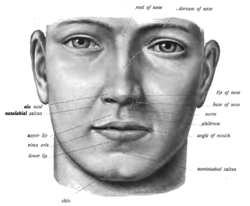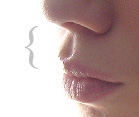Philtrum
| Philtrum | |
|---|---|
 Philtrum visible at centre | |
 Dog philtrum | |
| Details | |
| Precursor | medial nasal prominence[1] |
| Identifiers | |
| TA98 | A05.1.01.007 |
| TA2 | 222 |
| FMA | 59819 |
| Anatomical terminology | |
The philtrum (Template:Lang-la, Template:Lang-el philtron), or medial cleft, is a vertical groove in the middle area of the upper lip, common to many mammals, extending in humans from the nasal septum to the procheilon. Together with a glandular rhinarium and slit-like nostrils, it is believed to constitute the primitive condition for mammals in general.
Function
In most mammals, the philtrum is a narrow groove that may carry moisture from the mouth to the rhinarium or nose pad through capillary action, to keep the nose wet. A wet nose pad is able to trap odor particles better than a dry one, thus it greatly enhances the function of the olfactory system.
For humans and most primates, the philtrum survives only as a vestigial medial depression between the nose and upper lip.[2]
The human philtrum, bordered by ridges, also is known as the infranasal depression, but has no apparent function. That may be because most higher primates rely more on vision than on smell, and so no longer need a wet nose pad or a philtrum to keep the nose pad wet.[citation needed] Strepsirrhine primates, such as lemurs, still retain the philtrum and the rhinarium, unlike monkeys and apes.[3]

Development
In humans, the philtrum is formed where the nasomedial and maxillary processes meet during embryonic development (colloquially known as Hulse lines). When these processes fail to fuse fully in humans, a cleft lip (sometimes called a "hare lip") may result.
A flattened or smooth philtrum may be a symptom of fetal alcohol syndrome or Prader–Willi syndrome.[4]
Variation
A study of boys diagnosed with autism spectrum disorders found that a broader than average philtrum is one of a cluster of physical abnormalities associated with autism.[5]
Society and culture
In Jewish mythology, Lailah, the Angel of Conception, lightly taps an infant's upper lip before birth, whereupon the infant forgets the Torah she has taught it.[6] Some believers of the myth speculate that this is the cause of the philtrum, but it does not have a basis in traditional Jewish texts.[7]
In the movie Mr. Nobody, unborn infants are said to have knowledge of all past & future events. As an unborn infant is about to be sent to its mother, the "Angels of Oblivion" lightly tap its upper lip, whereupon the unborn infant forgets everything it knows. The movie follows the life story of one infant, whose lip hadn't been tapped.[8]
See also
- Cupid's bow
- Intermaxillary segment
- Mouth
- Toothbrush moustache (philtrum moustache)
References
- ^ hednk-032—Embryo Images at University of North Carolina
- ^ Philip Hershkovitz,Living New World monkeys (Platyrrhini): with an introduction to Primates, University of Chicago Press, 1977, Vol. I, p. 16
- ^ Ankel-Simons, F. (2007). Primate Anatomy (3rd ed.). Academic Press. p. 394. ISBN 978-0-12-372576-9.
- ^ FAS Clinical
- ^ Aldridge, Kristina; George, Ian D; Cole, Kimberly K; Austin, Jordan R; Takahashi, T Nicole; Duan, Ye; Miles, Judith H (2011). "Facial phenotypes in subgroups of prepubertal boys with autism spectrum disorders are correlated with clinical phenotypes". Molecular Autism. 2 (1): 15. doi:10.1186/2040-2392-2-15. PMC 3212884. PMID 21999758.
{{cite journal}}: CS1 maint: unflagged free DOI (link) - ^ Gabriel's Palace: Jewish Mystical Tales, p57
- ^ Babylonian Talmud; Niddah 30b
- ^ https://www.youtube.com/watch?v=i5MLaabdxvY
